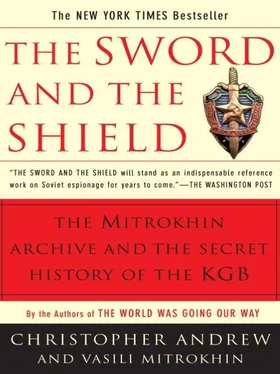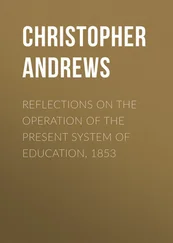The records of Directorate S revealed some remarkable individual achievements. KGB illegals successfully established bogus identities as foreign nationals in a great variety of professions ranging from Costa Rican ambassador to piano tuner to the Governor of New York. Even in the Gorbachev era, KGB propaganda continued to depict the Soviet illegal as the supreme embodiment of the chivalric ideal in the service of secret intelligence. The retired British KGB agent George Blake wrote in 1990:
Only a man who believes very strongly in an ideal and serves a great cause will agree to embark on such a career, though the word “calling” is perhaps appropriate here. Only an intelligence service which works for a great cause can ask for such a sacrifice from its officers. That is why, as far as I know, at any rate in peacetime, only the Soviet intelligence service has “illegal residents.” 18
The SVR continues the KGB tradition of illegal hagiography. In July 1995, a month after the death of the best-known American-born illegal, Morris Cohen, President Yeltsin conferred on him the posthumous title of Hero of the Russian Federation.
The files of Directorate S noted by Mitrokhin reveal a quite different kind of illegal. Alongside the committed FCD officers who maintained their cover and professional discipline throughout their postings, there were others who could not cope when confronted by the contrast between the Soviet propaganda image of capitalist exploitation and the reality of life in the West. An even darker secret of the Directorate S records was that one of the principal uses of the illegals during the last quarter of a century of the Soviet Union was to search out and compromise dissidents in the other countries of the Warsaw Pact. The squalid struggle against “ideological subversion” was as much a responsibility of Directorate S as of the rest of the FCD.
MITROKHIN WAS UNDERSTANDABLY cautious as he set out in 1972 to compile his forbidden FCD archive. For a few weeks he tried to commit names, codenames and key facts from the files to memory and transcribe them each evening when he returned home. Abandoning that process as too slow and cumbersome, he began to take notes in minuscule handwriting on scraps of paper which he crumpled up and threw into his wastepaper basket. Each evening, he retrieved his notes from the wastepaper and smuggled them out of Yasenevo concealed in his shoes. Gradually Mitrokhin became more confident as he satisfied himself that the Yasenevo security guards confined themselves to occasional inspections of bags and briefcases without attempting body searches. After a few months he started taking notes on ordinary sheets of office paper which he took out of his office in his jacket and trouser pockets.
Not once in the twelve years which Mitrokhin spent noting the FCD archives was he stopped and searched. There were, however, some desperately anxious moments. From time to time he realized that, like other FCD officers, he was being tailed—probably by teams from the Seventh (Surveillance) or Second Chief (Counter-intelligence) Directorates. On one occasion while he was being followed, he visited the Dynamo Football Club sports shop and, to his horror, found himself standing next to two English visitors whom his watchers might suspect were spies with whom he had arranged a rendezvous. If he was searched, his notes on top secret files would be instantly discovered. Mitrokhin quickly moved on to other sports shops, hoping to convince his watchers that he was on a genuine shopping expedition. As he approached his apartment block, however, he noticed two men standing near the door to his ninth-floor flat. By the time he arrived, they had disappeared. FCD officers had standing instructions to report suspicious incidents such as this, but Mitrokhin did not do so for fear of prompting an investigation which would draw attention to the fact that he had been seen standing next to English visitors.
Each night when he returned to his Moscow flat, Mitrokhin hid his notes beneath his mattress. On weekends he took them to a family dacha thirty-six kilometers from Moscow and typed up as many as possible, though the notes became so numerous that Mitrokhin was forced to leave some of them in handwritten form. He hid the first batches of typescripts and notes in a milk-churn which he buried below the floor. 19The dacha was built on raised foundations, leaving just enough room for Mitrokhin to crawl beneath the floorboards and dig a hole with a short-handled spade. He frequently found himself crawling through dog and cat feces and sometimes disturbed rats while he was digging, but he consoled himself with the thought that burglars were unlikely to follow him. When the milk-churn was full, he began concealing his notes and typescripts in a tin clothes-boiler. Eventually his archive also filled two tin trunks and two aluminum cases, all of them buried beneath the dacha. 20
Mitrokhin’s most anxious moment came when he arrived at his weekend dacha to find a stranger hiding in the attic. He was instantly reminded of the incident a few years earlier, in August 1971, when a friend of the writer Aleksandr Solzhenitsyn had called unexpectedly at his dacha while Solzhenitsyn was away and surprised two KGB officers in the attic who were probably searching for subversive manuscripts. Other KGB men had quickly arrived on the scene and Solzhenitsyn’s friend had been badly beaten. Andropov cynically ordered Solzhenitsyn to be “informed that the participation of the KGB in this incident is a figment of his imagination.” 21The incident was still fresh in Mitrokhin’s mind when he arrived at the dacha because he had recently noted files which recorded minutely detailed plans for the persecution of Solzhenitsyn and the “active measures” by which the KGB hoped to discredit him in the Western press. To his immense relief, however, the intruder in the attic turned out to be a homeless squatter.
During summer holidays Mitrokhin worked on batches of his notes at a second family dacha near Penza, carrying them in an old haversack and dressing in peasant clothes in order not to attract attention. In the summer of 1918 Penza, 630 kilometers southeast of Moscow, had been the site of one of the first peasant risings against Bolshevik rule. Lenin blamed the revolt on the kulaks (better-off peasants) and furiously instructed the local Party leaders to hang in public at least one hundred of them so that “for hundreds of kilometers around the people may see and tremble…” 22By the 1970s, however, Penza’s counter-revolutionary past was long forgotten, and Lenin’s bloodthirsty orders for mass executions were kept from public view in the secret section of the Lenin archive.
One of the most striking characteristics of the best literature produced under the Soviet regime is how much of it was written in secret. “To plunge underground,” wrote Solzhenitsyn, “to make it your concern not to win the world’s recognition—Heaven forbid!—but on the contrary to shun it: this variant of the writer’s lot is peculiarly our own, purely Russian, Russian and Soviet!” 23Between the wars Mikhail Bulgakov had spent twelve years writing The Master and Margarita, one of the greatest novels of the twentieth century, knowing that it could not be published in his lifetime and fearing that it might never appear at all. His widow later recalled how, just before his death in 1940, Bulgakov “made me get out of bed and then, leaning on my arm, he walked through all the rooms, barefoot and in his dressing gown, to make sure that the manuscript of The Master was still there” in its hiding place. 24Though Bulgakov’s great work survived, it was not published until a quarter of a century after his death. As late as 1978, it was denounced in a KGB memorandum to Andropov as “a dangerous weapon in the hands of [Western] ideological centers engaged in ideological sabotage against the Soviet Union.” 25
Читать дальше











